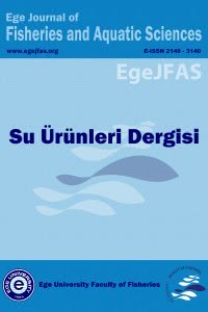The Effect of temperature on protein and amino acid composition of Spirulina platensis
prolin, protein, sıcaklık, arginin, amino asitler
Sıcaklığın Spirulina platensis’in protein ve amino asit kompozisyonu üzerine etkisi
proline, protein, temperature, arginine, amino acids,
___
- Becker, E.W., 1993. Development of Spirulina research in a developing country India. Bulletin de I, Institut Oceanographique (Monaco). (Spec. Issue 12) 65-75.
- Borowitzka, M.A., 1988. Vitamins and fine chemicals from micro-algae. In:Borowitzka (Eds.), Micro-Algal Biotechnology, Cambridge University Pres, Cambridge, UK. pp 153-196.
- Cohen, Z., A. Vonshak, A. Richmond, 1987. Fatty acid composition of Spirulina strains grown under various environmental conditions. Phytochemistry. 26 (8) 2255-2258.
- Guillard, R.R.L., 1973. Culture Methods and Growth Measurements, Division Rates in Handbook of Phycological methods J.R. Stein (Ed.), Chambridge University Pres, Chambridge. pp. 289-311.
- Işık, O., L. Hızarcı, S. Sayın, S. Gökpınar, Y. Durmaz, T. Göksan. 2006. The Effect of the Environmental Factors on the Vitamin C (Ascorbic Acid), E (Alpha-tocopherol), β-carotene Contents and the Fatty Acid Composition of Spirulina platensis. E.U. Journal of Fisheries & Aquatic Sciences Vol; 23 (3-4): 257–261.
- Koru, E., S. Cirik, 2002. Biochemical composition of Spirulina biomass in open-air system. Proceedings of ICNP. Trabzon. pp 97-100.
- Ogbonda, K.H., R.E. Aminigo, G.O.Abu, 2006. Influence of temperature and pH on biomass production and protein biosynthesis in a putative Spirulina sp. Bioresource Technology.
- Olguin, E., S. Galicia, O. Angulo-Guerrero, E. Hernndez, 2001. The effect of low light flux and nitrogen deficiency on the chemical composition of Spirulina sp. (Arthrospira) grown on digested pig waste. Biores. Technol. 77, 19-24.
- Parsons, T.R., J.D.H. Strickland, 1963. Discussion of spectrophotometric determination of marine plant pigments, with revised equations for ascertaining chlorophylls and carotenoids. J. Marine Research. 21No: 3, p.115-163.
- Reynolds, C.S., 1984. The ecology of Freshwater Phytoplankton. Cambridge University Press, Cambridge. 384 pp.
- Richmond, A., 1986. Outdoor Mass Cultures of Microalgae. (A. Richmond Editör). Handbook of Microalgal Mass Cultures of Microalgae. CRC Press, INC. Boca Raton, Florida. 285-329.
- Richmond, A., 1992. Mass culture of cyanobacterium. In: Photosynthetic Prokaryotes, N.H. Mann, N.G. Carr (Eds.), Plenum Press, New York pp 181-209.
- Richmond, A., E. Lichtenberg, B. Stahl, A. Vonshak, 1990. Quantitative assessment of the major limitations on productivity of Spirulina platensis in open raceways. J. Applied Phycology. 2 195-206.
- Soeder, C.J., J.F. Talling, I. Baak, 1969. Chemical components, Dry weight and ash content. A manual on methods for Measuring Primary Production in Aquatic Environments, A.R. Vollenweider (Ed.), Blackwell Scientific Publications, Edinburgh Melbourne.
- Tomaselli, L., G. Boldrini, M.C. Margheri, 1997. Physiological behaviour of Arthrospira (Spirulina) maxima during acclimation to changes in irradiance. Journal of Applied Phycology 9 37-43.
- Tomaselli, L., L. Giovannetti, A. Sacchi, F. Bocci, , 1988. Effects of temperature on growth and biochemical composition in Spirulina platensis strain M2. In: Algal Biotechnology, T. Stadler, J. Mellion, M.C. Verdus, Y. Karamanos, H. Morvan, D. Christiaen (Eds.), Elsevier Applied Science, London. pp 303-314.
- Torzillo, G., F. Giovanetti, R. Bocci, L. Materassi, 1984. Effect of oxygen concentration on the protein content of Spirulina biomass.
- Vonshak, A., 1992. Microalgal biotechnology: is it an economical success?. In Biotechnology:Economic and Social Aspects, E.J. Da Silva, C. Ratledge, A, Sasson (Eds.), Cambridge University. pp 70-80.
- ISSN: 1300-1590
- Yayın Aralığı: 4
- Başlangıç: 1984
- Yayıncı: Aynur Lök
Marmara Adası kıyı balıkçılığı ve balıkçılık kaynakları
OKAN AKYOL, TEVFİK CEYHAN, OKAN ERTOSLUK
Determination of shelf life in fried and boiled frog meat stored in refrigerator in 3.2± 1.08°C
ŞÜKRAN ÇAKLI, DUYGU KIŞLA, Aslı CADUN, MEHMET TOLGA DİNÇER, EMRE ÇAĞLAK
The Effect of temperature on protein and amino acid composition of Spirulina platensis
Leyla Hızarcı USLU, OYA IŞIK, Selin SAYIN, YAŞAR DURMAZ, TOLGA GÖKSAN, ŞEVKET GÖKPINAR
Tahtalı Baraj Gölü (İzmir)’nün zooplankton kompozisyonu
DİDEM ÖZDEMİR MİS, CEM AYGEN, M. Ruşen USTAOĞLU, Süleyman BALIK
Keban Baraj Gölü Pertek Bölgesi Balıkçılarının sosyo-ekonomik analizi
Mürşide DARTAY, ERDAL DUMAN, MUHSİNE DUMAN, TUNCAY ATEŞŞAHİN
Current situation and hygiene practices In seafood processing plants in Aegean and Marmara Regions
Nihan ARAL, Taçnur BAYGAR, Muammer KAPLAN
Türkiye’de balıkçılık istatistiklerinin iyileştirilmesi ve Avrupa Birliği uyum süreci
Doğal levrek (Dicentrarchus labrax) anaçlarında mikrosatelit polimorfizmi
Deep-Water Decapod Crustacean Fauna of the Sıgacık Bay, Aegean Sea coast of Turkey
Karagöl’ün (Dağ Gölü, İzmir-Türkiye) alg florası ve çevresel koşullarının mevsimsel değişimi
